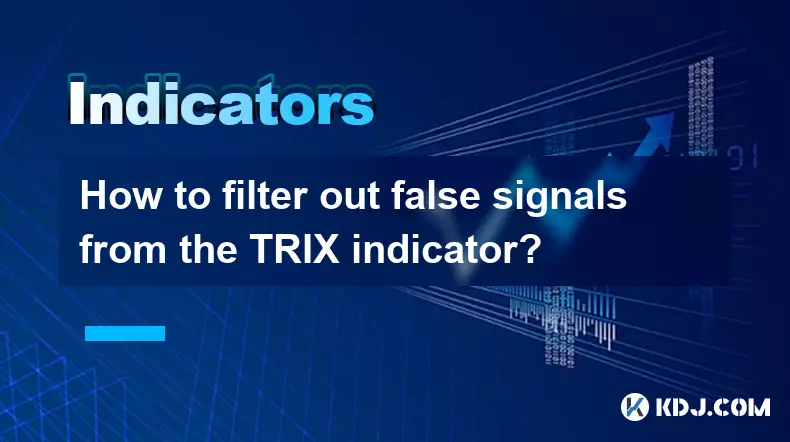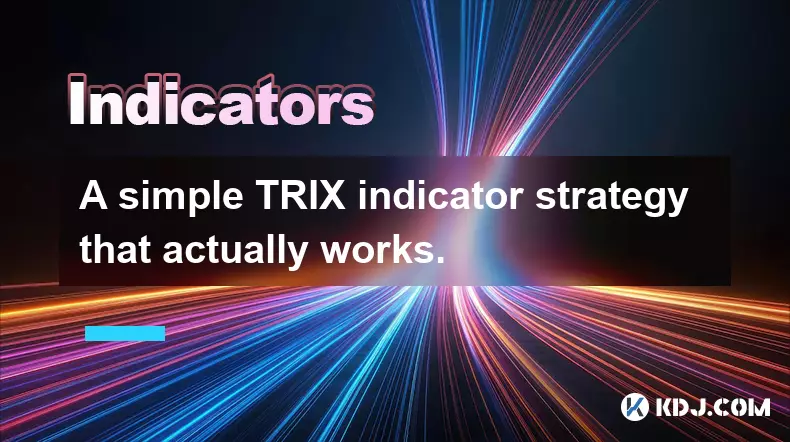-
 bitcoin
bitcoin $102877.190955 USD
1.88% -
 ethereum
ethereum $3430.435064 USD
4.52% -
 tether
tether $0.999264 USD
-0.05% -
 xrp
xrp $2.307310 USD
4.49% -
 bnb
bnb $987.740692 USD
3.82% -
 solana
solana $161.947760 USD
3.97% -
 usd-coin
usd-coin $0.999712 USD
-0.05% -
 tron
tron $0.292810 USD
2.93% -
 dogecoin
dogecoin $0.179738 USD
10.70% -
 cardano
cardano $0.580716 USD
8.75% -
 hyperliquid
hyperliquid $42.463448 USD
8.40% -
 chainlink
chainlink $15.763437 USD
7.05% -
 zcash
zcash $649.595636 USD
17.21% -
 bitcoin-cash
bitcoin-cash $511.610261 USD
7.19% -
 stellar
stellar $0.292537 USD
7.91%
How to filter out false signals from the TRIX indicator?
The TRIX indicator helps filter noise in crypto markets, but combining it with volume, moving averages, and on-chain data improves signal accuracy and reduces false entries.
Nov 06, 2025 at 12:49 pm

Understanding the TRIX Indicator in Crypto Markets
1. The TRIX (Triple Exponential Average) indicator is a momentum oscillator used to identify oversold and overbought conditions, as well as potential trend reversals in cryptocurrency price action. It applies triple exponential smoothing to price data, filtering out minor fluctuations and focusing on sustained trends. In volatile markets like Bitcoin or Ethereum, this helps traders avoid reacting to short-term noise.
2. Because cryptocurrencies often experience sharp spikes and sudden corrections, raw signals from oscillators can be misleading. The TRIX line crossing above or below the signal line may suggest buy or sell opportunities, but not all crossings result in actual trend continuation. This leads to false entries if interpreted without additional context.
3. One key way to assess the reliability of a TRIX signal is by observing its position relative to the zero line. When the TRIX crosses above zero, it indicates bullish momentum; crossing below suggests bearish momentum. However, during sideways market phases, these crossovers occur frequently without meaningful price movement, creating false positives.
4. To reduce such inaccuracies, traders should combine TRIX with volume analysis. A crossover supported by increasing trading volume is more likely to reflect genuine market interest. For example, if Bitcoin’s TRIX crosses above the signal line while exchange volume surges, the signal gains credibility.
5. Another method involves using longer timeframes to confirm signals generated on shorter ones. If the 4-hour TRIX shows a bullish crossover, checking the daily chart ensures alignment with the broader trend. Discrepancies between timeframes often expose false signals originating from temporary volatility.
Use Multiple Confirmation Tools Alongside TRIX
1. Relying solely on TRIX increases exposure to erroneous signals, especially during consolidation periods common in altcoin markets. Integrating complementary indicators enhances accuracy. The Relative Strength Index (RSI), for instance, helps determine whether an asset is overextended before acting on a TRIX signal.
2. Moving averages serve as dynamic support and resistance levels. When the TRIX generates a buy signal and the price is also bouncing off a key moving average—such as the 50-period or 200-period EMA—the likelihood of a valid move increases significantly.
3. MACD can provide parallel momentum confirmation. Since both MACD and TRIX are based on exponential moving averages, comparing their directional bias strengthens decision-making. If both indicators show converging bullish momentum, the trade setup becomes more robust.
4. Candlestick patterns offer visual cues that align with TRIX readings. A bullish engulfing pattern appearing at the same time as a TRIX zero-line crossover adds confluence, reducing the risk of entering on a false breakout.
5. On-chain metrics specific to crypto assets further validate technical signals. Metrics like exchange netflow or active addresses can indicate whether institutional or retail activity supports the price movement suggested by TRIX.
Adjust Smoothing Parameters Based on Market Volatility
1. Default TRIX settings typically use a 15-period triple EMA, which works well in trending environments but lags during high-frequency swings seen in meme coins or newly listed tokens. Adjusting the period length allows customization based on current volatility.
2. In highly volatile conditions, shortening the period makes TRIX more responsive, though it may increase false signals. Conversely, extending the period smooths out erratic movements, making crossovers more reliable but potentially delayed.
3. Traders can apply adaptive periods tied to the Average True Range (ATR). When ATR rises, indicating higher volatility, they might switch to a longer TRIX setting to filter excessive noise. During low volatility, a shorter setting captures early momentum shifts.
4. Testing different configurations through backtesting historical crypto price data improves parameter selection. For stablecoins or large-cap cryptos like Binance Coin, longer periods often perform better due to slower trend development.
5. Some advanced platforms allow dynamic optimization where TRIX parameters auto-adjust based on recent market behavior. While complex, this approach minimizes manual intervention and adapts quickly to changing conditions.
Frequently Asked Questions
What causes false signals in the TRIX indicator?False signals primarily arise during range-bound markets when prices lack direction. Frequent crossovers happen without follow-through because no dominant trend exists. Sudden news events or whale trades in crypto can also distort price temporarily, triggering misleading TRIX movements.
Can the TRIX indicator be used effectively on low-cap altcoins?Yes, but with caution. Low-cap altcoins exhibit extreme volatility and susceptibility to manipulation. Using tighter stop-losses and combining TRIX with volume spikes helps mitigate risks. Signals should only be acted upon when confirmed by order book depth and social sentiment trends.
Is the TRIX indicator suitable for scalping in crypto futures?It can be adapted for scalping by reducing the smoothing period and pairing it with Level 2 order book data. However, due to inherent lag from triple smoothing, pure scalpers often prefer faster oscillators. TRIX works best in 15-minute to 1-hour scalping windows rather than sub-five-minute charts.
Disclaimer:info@kdj.com
The information provided is not trading advice. kdj.com does not assume any responsibility for any investments made based on the information provided in this article. Cryptocurrencies are highly volatile and it is highly recommended that you invest with caution after thorough research!
If you believe that the content used on this website infringes your copyright, please contact us immediately (info@kdj.com) and we will delete it promptly.
- Ripple (XRP) in 2026: Hold or Fold? A Look at XRP's Future and Emerging DeFi Alternatives
- 2025-11-08 18:35:01
- Zcash ZEC Coin Price Explosion: From Privacy Niche to Center Stage
- 2025-11-08 18:55:01
- Berachain Price Prediction: Navigating the Honeycomb Hype in Crypto
- 2025-11-08 18:55:01
- Arthur Hayes, Gold, and Bitcoin: A Modern Monetary Trinity?
- 2025-11-08 19:15:01
- Shiba Inu's Next Move: Navigating a Shifting Market
- 2025-11-08 19:20:01
- Pakistan's Crypto Crossroads: Balancing Opportunity with Asset-Backed Realities
- 2025-11-08 19:20:01
Related knowledge

How do professional traders use the TRIX indicator?
Nov 06,2025 at 04:40pm
Understanding the TRIX Indicator in Crypto TradingThe TRIX (Triple Exponential Average) indicator is a momentum oscillator used by professional trader...

Can I use the TRIX indicator on my mobile trading app?
Nov 07,2025 at 07:40pm
The TRIX indicator, a momentum oscillator designed to filter out short-term fluctuations and highlight long-term trends, has become increasingly popul...

How to code a simple TRIX indicator script in Pine Script?
Nov 07,2025 at 06:20am
How to Code a Simple TRIX Indicator in Pine Script The TRIX (Triple Exponential Moving Average) indicator is widely used in cryptocurrency trading to ...

A simple TRIX indicator strategy that actually works.
Nov 08,2025 at 05:39pm
Understanding the TRIX Indicator in Crypto Trading1. The TRIX (Triple Exponential Average) indicator is a momentum oscillator designed to filter out s...

How to trade TRIX indicator signals on the 1-hour chart?
Nov 07,2025 at 05:39am
Bitcoin's Role in Decentralized Finance1. Bitcoin remains the cornerstone of decentralized finance, serving as a benchmark for value and security acro...

Can the TRIX indicator be used for long-term investing?
Nov 06,2025 at 02:19pm
Understanding the TRIX Indicator in Cryptocurrency Markets1. The TRIX (Triple Exponential Average) indicator is a momentum oscillator designed to filt...

How do professional traders use the TRIX indicator?
Nov 06,2025 at 04:40pm
Understanding the TRIX Indicator in Crypto TradingThe TRIX (Triple Exponential Average) indicator is a momentum oscillator used by professional trader...

Can I use the TRIX indicator on my mobile trading app?
Nov 07,2025 at 07:40pm
The TRIX indicator, a momentum oscillator designed to filter out short-term fluctuations and highlight long-term trends, has become increasingly popul...

How to code a simple TRIX indicator script in Pine Script?
Nov 07,2025 at 06:20am
How to Code a Simple TRIX Indicator in Pine Script The TRIX (Triple Exponential Moving Average) indicator is widely used in cryptocurrency trading to ...

A simple TRIX indicator strategy that actually works.
Nov 08,2025 at 05:39pm
Understanding the TRIX Indicator in Crypto Trading1. The TRIX (Triple Exponential Average) indicator is a momentum oscillator designed to filter out s...

How to trade TRIX indicator signals on the 1-hour chart?
Nov 07,2025 at 05:39am
Bitcoin's Role in Decentralized Finance1. Bitcoin remains the cornerstone of decentralized finance, serving as a benchmark for value and security acro...

Can the TRIX indicator be used for long-term investing?
Nov 06,2025 at 02:19pm
Understanding the TRIX Indicator in Cryptocurrency Markets1. The TRIX (Triple Exponential Average) indicator is a momentum oscillator designed to filt...
See all articles





















![The Graph Price Prediction [GRT Crypto Price News Today] The Graph Price Prediction [GRT Crypto Price News Today]](/uploads/2025/11/07/cryptocurrencies-news/videos/690d4df44fe69_image_500_375.webp)



















































